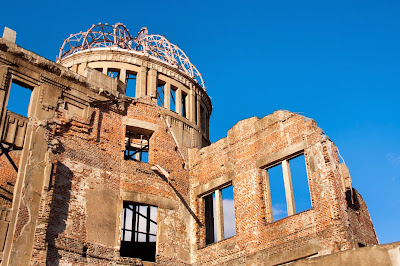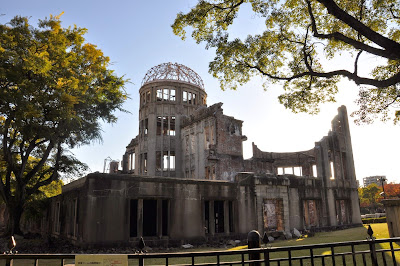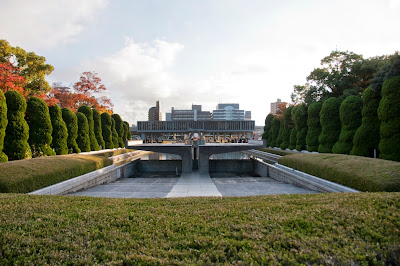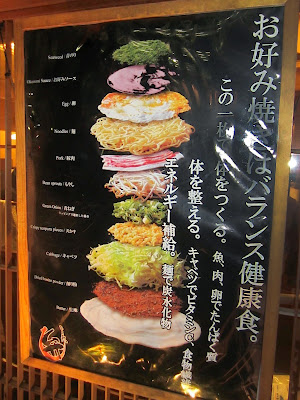A surprisingly common
question I’ve gotten is, “why did you go
to Hiroshima?” to which my response is always, “how could I not?!” For better or worse, the city of Hiroshima has
a solid if unfortunate place in history—Japanese history, American history, and
world history. There are few places in the world that have a sense of “living
history”. When you visit ancient sights, they can feel just that: ancient and
distant. But it is simultaneously chilling and enthralling to visit a place
where history is more palpable. Places I have experienced this unique energy
include Pearl Harbor, The Kremlin, Berlin, Westminster Abbey, and Dealey Plaza
in Dallas. Now I would add Hiroshima to this list: how often can you stand in a
spot where the history of the world changed in an instant with the flash of the
first—and worst—of only two nuclear bombs ever used in war?

The other, more expected
question I get is, “did it feel weird to
be there as an American?” The answer to that one is definitely not. I
suppose the answer to that lies somewhat in the mind of any American visitor,
based on whether they believe the bombing of Hiroshima was justified…but there
is nothing about the place or the people that is anti-American. The Japanese have
generally acknowledged their own aggression and acts of war that led up to
Hiroshima, and as one of only two cities to know first-hand the horror that
comes from nuclear warfare, the loud and clear statement of the memorials is a
purely nation-agnostic one: nuclear weapons should cease to exist, period. Especially
when you consider that today’s nuclear warheads are nearly one thousand times
more powerful than the ones that were dropped on Hiroshima and Nagasaki. To
this day, when any nation performs a nuclear test, the sitting mayor of
Hiroshima sends the leader of that nation a letter reminding them of the
destruction and asking them to give up their pursuit of nuclear weapons.

Other than the memorials,
there’s not much to see or do in Hiroshima. It’s a thoroughly modern city
rebuilt on the ashes of the old. For me there was a peculiar strangeness to
that; I guess because we only associate Hiroshima with the bombing and nothing
else, it seemed surreal to me to stay at the Sheraton Hiroshima or to grab a
cheeseburger at a Hiroshima McDonald’s.
Of course our first day was
spent at the Hiroshima Peace Memorial Park. Most of the park is on an island in
the Ōta River. A T-shaped bridge connecting this island with the mainland on
both sides (the Aioi Bridge) was the visual target for the atomic bomb because
it was easily recognized from the air. Hence this area is “Ground zero” and was
completely obliterated.
Well, almost completely— the
first thing you see are the ruins of the former Industrial Promotion Hall, now
called the Genbaku Dōmu (A-bomb Dome). This was the only structure left
standing near the bomb’s hypocenter, owing to combination of good construction
(stone versus wood, as was used for most traditional Japanese buildings) as
well as the fact that the force of the bomb came from overhead instead of from
the side, which would have knocked it down. Anyone inside the building,
however, was killed instantly. The decaying shell has been left standing as a
reminder of the bomb’s destruction.






Crossing over to the island
portion of the Peace Park, you find a number of monuments and memorials as well
as the museum. The Children's Peace Monument features a girl with outstretched
arms and an origami crane. It was inspired by the story of Sadako Sasaki, a
12-year-old girl who died from leukemia attributed to the atomic bomb.
According to Japanese legend, anyone who folds 1,000 origami cranes will be
granted a wish or recovery from illness. So Sadako began to fold cranes shortly
before her death. To this day, the statue is surrounded by cases of paper
cranes containing a continuously replenished collection made and sent by
children around the world. Although inspired by Sadako, the monument is
dedicated to all children who died in the blast.




Among the dozens of other
memorials that dot the park are the Peace Bells which visitors are encouraged
to ring, and the Memorial Mound—a grassy knoll that contains the ashes of
70,000 unidentified victims of the bomb. But the main ones are the Memorial
Cenotaph and the Flame of Peace. The cenotaph sits under a concrete arch that
contains the names of all of the bomb’s victims and frames a view of the flame
and the A-Bomb Dome. An epitaph reads, “Please rest in peace, for the error
shall not be repeated”; it is deliberately ambiguous so as to be apolitical.
The flame is also dedicated to the memory of the bombing’s victims. Although it
has burned continuously since being lit in 1964, it is not an “eternal flame”:
the intention is that it will be extinguished when all atomic weapons are earth
are destroyed and the planet is free from the threat of nuclear destruction.





Ultimately this all leads to
the Hiroshima Peace Memorial Museum. It covers everything from the buildup to
and destruction from the bombing of Hiroshima to the current threat of nuclear
arms. Most affecting are the personal belongings and stories of some of the
victims.
This striking diorama shows the city’s
center before and after the bombing.
This pocket watch stopped at
8:15AM, the exact moment that the bomb exploded.
These shorts belonged to a
12-year-old boy named Jiro Mitsuda. They were all that was left on his body
when the rest of his clothes—and much of his flesh—were seared off by the
blast. He made it home to help his mother and put out the flames that were
engulfing his house. He died 5 days later after deliriously asking for money to
buy an ice pop.
This drawing was made by his
father and shows him cremating his son’s body.
There are some of the actual
cranes made by Sadako Sasaki. They are tiny because she didn’t have much paper
and made them out of whatever scraps she could find in the hospital, including
medicine labels.
These are the steps from a
bank near the hypocenter. Someone was sitting on them, waiting for the bank to
open when the bomb struck. The person was vaporized, but the flash of radiation
from the bomb seared their shadow on these steps for all eternity.
An evening view over the
Peace Park.
That night we decided to hit
another cuisine we hadn’t yet sampled in Japan, a steakhouse. Yum!
Walking around Hiroshima by
night, we came upon a pageant of Christmas lights (again, I found this somewhat
surreal)…
…and a store where I began to
feel a little crabby.
All that walking made us
hungry again, so we went to the famous Okonomi-mura or “Okonomiyaki Village”.
It features 3 floors containing no less than 26 okonomiyaki stands, each
serving their own style of okonomiyaki. For a newfound okonomiyaki lover, this
was like Disneyland! All of the
okonomiyaki here are generally of the Hiroshima style, which is a layered
variation heavy on cabbage that’s served over noodles. We randomly picked this
place because there seemed to be a few natives there and we liked the
no-nonsense older lady who worked there.






The
next day—our last full one in Japan—we headed off to Miyajima (“Shrine
Island”), the popular name for the island officially known as Itsukushima. A short ferry ride from the mainland, about an hour
from Hiroshima, it is considered one of
the 3 most beautiful places and Japan—and you’ll get no argument from me. This
small, mountainous island is sparsely populated and covered with shrines,
including the famous and eponymous Itsukushima Shrine, all of
which—especially its bright red torii gate—appears to float on water during
high tide.
We
walked around the perimeter of the island a bit, taking in the sights.
Among
the sights are wild deer that live on the island and don’t seem to care a whit
about the humans there. Any why should they? Shinto consider them to be sacred
messengers of the gods so they live the life of Riley. The walk and sleep
wherever they want.
I
particularly enjoyed watching this photographer who offered photos in front of
the floating torii. He had an assistant whose Sisyphean task was to try to
wrangle one or two deer to be in the picture with you and then shoo away any
other deer that tried to get in on the act.
At
the heart of the island is Mount
Misen, rising to 535 meters. You can hike to the top or take a cable
car—although even the cable car involves a little hiking at the bottom and at
the top. Karen opted for the full hike experience while I enjoyed the cable
car. This sign directing you to the cable car (ropeway)
station was perhaps my favorite one in all of Japan:
Either way, the views from
the top are impressive. We had beautiful weather and a clear view over the Seto
Inland Sea and as far as Hiroshima.
For our last dinner in
Japan, we went to a kaiseki restaurant high atop a hotel in Hiroshima. A view
over the Memorial Park makes for an odd dining ambiance but the food was of
course served with flair.
We strolled around a bit,
had drinks, and visited our last Lawson’s Station. That was particularly
bittersweet, as this omnipresent chain of convenience stores became practically
a daily ritual for us. No matter where you are in Japan, there seems to be a
Lawson’s right there. They’re
everywhere! And the perfect place to stock up on snacks and other essentials.
Technically it turned out that this was NOT the last one we went to, because of
course there were multiple locations
right in Haneda Airport…but I digress.
Actually our evening ended
on a slightly more mundane note. Returning to our hotel we decided to check out
the gym, since we would have some free time in the morning. We ended up finding
ourselves locked inside the gym for a good 20 minutes before help arrived!
Here's Karen trying to make the best of the situation...
The next day involved a
loooong train trip back up to Tokyo—maybe 5 or 6 hours, thanks to the
Shinkansen—for our evening flights back to the US. We were flying separately so
after a few final moments together in an airport hotel where you pay by the
hour to sleep in a box (ah, Japan) we bade each other—and our Japanese hosts—a
fond sayonara.
So like I said up front,
Japan was amazing. I have never been to a country where the culture was so
fundamentally different and the people so overwhelmingly caring and welcoming.
This is definitely one where my most outstanding memories will not be of the
sights—though there were plenty of beautiful ones—but of the experiences I had
and the kindhearted people I encountered.
And in the interest of
kindness, I’d like to issue a public apology to Karen for making her nights
miserable. Apparently I’ve become a snorer in my old age! So it was a journey
of self-discovery too. On to the next one!
With the gems of Kyoto but a recent memory, we headed to our next and final destination, Hiroshima. BUT BEFORE WE GO…A FEW PARTING SHOTS!
Momiji manjū (little maple-leaf–shaped cakes) are a specialty of the region, and for some reason it seems to have an association with loving relationships. But the description in small type below just sounds so dirty (click to enlarge):
Karen found her ideal
boyfriend on this vending machine.
We found a clothing store
called "Womb" that had freaky cryptic signs like this on the
clothing...
And the last few funny signs...
(I know that last one was a repeat, but again it was my favorite!)
Sayonora!


























































































